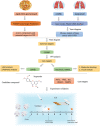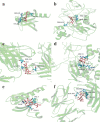The mechanism and candidate compounds of aged citrus peel (chenpi) preventing chronic obstructive pulmonary disease and its progression to lung cancer - PubMed (original) (raw)
The mechanism and candidate compounds of aged citrus peel (chenpi) preventing chronic obstructive pulmonary disease and its progression to lung cancer
Lin Zhou et al. Food Nutr Res. 2021.
Abstract
Background: Chronic obstructive pulmonary disease (COPD) is an important risk factor for developing lung cancer. Aged citrus peel (chenpi) has been used as a dietary supplement for respiratory diseases in China.
Objective: To explore the mechanism and candidate compounds of chenpi preventing COPD and its progression to lung cancer.
Methods: The active components and potential targets of chenpi were retrieved from the Traditional Chinese Medicine Systems Pharmacology (TCMSP) database. Disease-associated targets of COPD and lung cancer were collected in the Gene Cards and TTD database. The component-target network and PPI network were constructed using the Cytoscape 3.8.0 software. David database was used for GO and KEGG enrichment analysis. The main active components were verified by using the autodock Vina 1.1.2 software. Mouse lung cancer with COPD was induced by cigarette smoking (CS) combined with urethane injection to confirm preventing the effect of hesperetin (the candidate compound of chenpi) on COPD progression to lung cancer and its underlying mechanisms.
Results: The network analysis revealed that the key active components of chenpi (nobiletin, naringenin, hesperetin) regulate five core targets (AKT1, TP53, IL6, VEGFA, MMP9). In addition, 103 potential pathways of chenpi were identified. Chenpi can prevent COPD and its progression to lung cancer by getting involved in the PI3K-Akt signaling pathway and MAPK signaling pathway. Molecular docking indicated that hesperetin had better binding activity for core targets. In mouse lung cancer with COPD, treatment with hesperetin dose-dependently improved not only lung tissue injury in COPD but also carcinoma lesions in lung cancer. Meanwhile, hesperetin could suppress the protein expression of AKT1, IL6, VEGFA, MMP9 and up-regulate the protein expression of TP53, and thus reduced the risk of COPD progression to lung cancer.
Conclusion: Hesperetin is a candidate compound of chenpi that helps in preventing COPD and its progression to lung cancer by regulating AKT1, IL6, VEGFA, MMP9 and TP53.
Keywords: chenpi; chronic obstructive pulmonary disease (COPD); hesperetin; lung cancer; network pharmacology.
© 2021 Lin Zhou et al.
Conflict of interest statement
The authors have declared no conflict of interest. This study was supported by the Youth Natural Science Foundation of Henan Province of China. (No. 212300410109), the Postgraduate Education Innovation and Quality Improvement Project of Henan University (No. SYL19060139-140, SYL18060136-137, SYL20060159-160) and the Scientific Research Foundation for Postdoctoral Science Foundation of Henan Province of China.
Figures
Fig. 1
The research scheme in this experiment.
Fig. 2
The 2D structure of active components in chenpi. (a) The 2D structure of nobiletin. (b)The 2D structure of hesperetin. (c) The 2D structure of citromitin. (d) The 2D structure of naringenin. (e) The 2D structure of sitosterol.
Fig. 3
The network of _chenpi_-COPD and lung cancer intersection targets. (a) The components–targets network. A network with 174 nodes and 342 edges linking five compounds in chenpi and 169 target genes. The red nodes represent the targets, the purple nodes represent the compounds. (b) Venn diagram. (c) The PPI network containing 169 nodes and 1,992 edges. The node represents the protein, and the edge represents the interaction between proteins.
Fig. 4
GO and KEGG pathway enrichment analysis. (a) Histogram of GO enrichment analysis. (b) Histogram of KEGG enrichment analysis. (c)Visualization of KEGG enrichment analysis.
Fig. 5
Pattern diagram of molecular docking. (a) Hesperetin-AKT1, (b) hesperetin-MMP9, (c) hesperetin-IL6, (d) naringenin-MMP9, (e) nobiletin-AKT1, (f) nobiletin-IL6.
Fig. 6
The preventive efficacy of hesperetin on urethane and CS-induced lung cancer with COPD. (a) Schematic design of the experimental procedure. (b) Tidal volume (TV) in lung function. (c) The whole lung at 4 and 8 weeks after urethane injection and CS exposure to the naked eye. (d) HE staining of lung tissues. (e) Lung injury score. (f) Lung W/D ratio. (g) The number of lung nodes at 8 weeks. The data are presented as the mean ± SD (n = 10), the experiments were repeated three times and statistical significance was determined by a t test. *P < 0.05, **P < 0.01 vs. normal; #P < 0.05, ##P < 0.01 vs. the model.
Fig. 7
Hesperetin regulates the core targets of COPD and lung cancer in urethane and CS-induced lung cancer with COPD. (a) Protein expression of core targets examined by western blot in COPD stage. (b) Protein expression of core targets examined by western blot in the lung cancer stage. The data are presented as the mean ± SD (n = 10), the experiments were repeated three times and statistical significance was determined by a t test. *P < 0.05, **P < 0.01 vs. normal; #P < 0.05, ##P < 0.01 vs. the model.
Fig. 8
Hesperetin regulates the core targets of COPD and lung cancer in urethane and CS-induced lung cancer with COPD examined by immunofluorescence. The data are presented as the mean ± SD (n = 10), the experiments were repeated three times, and statistical significance was determined by a t test. *P < 0.05, **P < 0.01 vs. normal; #P < 0.05, ##P < 0.01 vs. the model.
Fig. 9
Hesperetin as a candidate compound of chenpi prevents COPD and its progression to lung cancer by regulating AKT1, IL6, VEGFA, MMP9 and TP53 in mouse lung cancer with COPD induced by CS and urethane.
Similar articles
- Common mechanism of Citrus Grandis Exocarpium in treatment of chronic obstructive pulmonary disease and lung cancer.
Zhou W, Dong M, Wu H, Li HL, Xie JL, Ma RY, Su WW, Dai JY. Zhou W, et al. Chin Herb Med. 2021 Aug 27;13(4):525-533. doi: 10.1016/j.chmed.2021.08.005. eCollection 2021 Oct. Chin Herb Med. 2021. PMID: 36119362 Free PMC article. - The mechanism and active compounds of semen armeniacae amarum treating coronavirus disease 2019 based on network pharmacology and molecular docking.
Wang Y, Gu W, Kui F, Gao F, Niu Y, Li W, Zhang Y, Guo Z, Du G. Wang Y, et al. Food Nutr Res. 2021 Feb 4;65. doi: 10.29219/fnr.v65.5623. eCollection 2021. Food Nutr Res. 2021. PMID: 34908920 Free PMC article. - Tiao-Bu-Fei-Shen Formula Improves Glucocorticoid Resistance of Chronic Obstructive Pulmonary Disease via Downregulating the PI3K-Akt Signaling Pathway and Promoting GR_α_ Expression.
Zhou P, Ma J, Yu W, Chen K, Zhang W, Zhou J. Zhou P, et al. Evid Based Complement Alternat Med. 2023 Feb 11;2023:4359616. doi: 10.1155/2023/4359616. eCollection 2023. Evid Based Complement Alternat Med. 2023. PMID: 36820399 Free PMC article. - Exploration of the mechanism of Zisheng Shenqi decoction against gout arthritis using network pharmacology.
Li WH, Han JR, Ren PP, Xie Y, Jiang DY. Li WH, et al. Comput Biol Chem. 2021 Feb;90:107358. doi: 10.1016/j.compbiolchem.2020.107358. Epub 2020 Aug 8. Comput Biol Chem. 2021. PMID: 33243703 Review. - Progression of the PI3K/Akt signaling pathway in chronic obstructive pulmonary disease.
Liu Y, Kong H, Cai H, Chen G, Chen H, Ruan W. Liu Y, et al. Front Pharmacol. 2023 Sep 20;14:1238782. doi: 10.3389/fphar.2023.1238782. eCollection 2023. Front Pharmacol. 2023. PMID: 37799975 Free PMC article. Review.
Cited by
- Herb-symptom analysis of Erchen decoction combined with Xiebai powder formula and its mechanism in the treatment of chronic obstructive pulmonary disease.
Ye H, He B, Zhang Y, Yu Z, Feng Y, Wen C, Xi C, Feng Q. Ye H, et al. Front Pharmacol. 2023 May 19;14:1117238. doi: 10.3389/fphar.2023.1117238. eCollection 2023. Front Pharmacol. 2023. PMID: 37274103 Free PMC article. - Hesperidin inhibits tobacco smoke-induced pulmonary cell proliferation and EMT in mouse lung tissues via the p38 signaling pathway.
Liang Z, Zhang Y, Xu Y, Zhang X, Wang Y. Liang Z, et al. Oncol Lett. 2022 Nov 29;25(1):30. doi: 10.3892/ol.2022.13616. eCollection 2023 Jan. Oncol Lett. 2022. PMID: 36589667 Free PMC article. - Hesperidin Reversed Long-Term _N_-methyl-_N_-nitro-_N_-Nitroguanidine Exposure Induced EMT and Cell Proliferation by Activating Autophagy in Gastric Tissues of Rats.
Liang Z, Song J, Xu Y, Zhang X, Zhang Y, Qian H. Liang Z, et al. Nutrients. 2022 Dec 11;14(24):5281. doi: 10.3390/nu14245281. Nutrients. 2022. PMID: 36558440 Free PMC article. - Bibliometric analysis of traditional Chinese medicine for smoking cessation.
Xing J, Liu J, Han M, Jiang Y, Jiang J, Huang H. Xing J, et al. Tob Induc Dis. 2022 Nov 9;20:97. doi: 10.18332/tid/154961. eCollection 2022. Tob Induc Dis. 2022. PMID: 36407938 Free PMC article. - Plant-Derived Natural Products as Lead Agents against Common Respiratory Diseases.
Oriola AO, Oyedeji AO. Oriola AO, et al. Molecules. 2022 May 10;27(10):3054. doi: 10.3390/molecules27103054. Molecules. 2022. PMID: 35630531 Free PMC article. Review.
References
LinkOut - more resources
Full Text Sources
Research Materials
Miscellaneous








